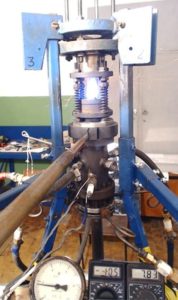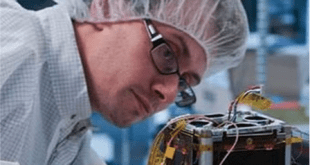
A so-called “self-eating” rocket engine is being developed by the universities of Scotland and Ukraine. It will be capable of putting small satellites into orbit at competitive price.
In a paper published in the Journal of Spacecraft and Rockets, engineers from the University of Glasgow and the Oles Honchar Dnipro National University (city of Dnipro, Ukraine) describe the process of assembling an “autophage” engine, firing it and throttling it up and down. The new engine can change the small satellite launch industry.
Today most rockets use tanks to store rocket fuel and their weight is usually many times greater than the weight of the payload. Thus, a launch vehicle’s efficiency is reduced, and the problem of space debris is increased.
However, a launch vehicle equipped with “autophage” engines would consume its own structure during take-off, which can increase the carrying capacity and reduce the amount of new debris in orbit.
In the “autophage” engine a rod with solid fuel outside and oxidizer inside is consumed. The solid fuel can be a strong plastic such as polyethylene. The rod is essentially a pipe filled with a powdered oxidizer. When the rod is inserted into the hot engine, the fuel and oxidizer evaporate and enter the combustion chamber. This produces thrust and the heat required for evaporation of the next rod section.
According to the researchers, the engine can be throttled by changing the speed at which the rod is inserted into the engine. For most models of solid fuel engines, throttling is impossible. The team has achieved the engine running time of 60 seconds so far.
Dr. Patrick Harkness, senior lecturer at the University of Glasgow’s School of Engineering, who leads the work on a new engine at his university, says: “Over the last decade, Glasgow has become a centre of excellence for the UK space industry, particularly in small satellites known as ‘CubeSats’, which provide researchers with affordable access to space-based experiments. There’s also potential for the UK’s planned spaceport to be based in Scotland.
“However, launch vehicles tend to be large because you need a large amount of propellant to reach space. If you try to scale down, the volume of propellant falls more quickly than the mass of the structure, so there is a limit to how small you can go. You will be left with a vehicle that is smaller but, proportionately, too heavy to reach an orbital speed.
“A rocket powered by an autophage engine would be different. The propellant rod itself would make up the body of the rocket, and as the vehicle climbed the engine would work its way up, consuming the body from base to tip.
“That would mean that the rocket structure would actually be consumed as fuel, so we wouldn’t face the same problems of excessive structural mass. We could size the launch vehicles to match our small satellites, and offer more rapid and more targeted access to space.
“While we’re still at an early stage of development, we have an effective engine testbed in the laboratory in Dnipro, and we are working with our colleagues there to improve it still further. The next step is to secure further funding to investigate how the engine could be incorporated into a launch vehicle.
The paper, titled Autophage Engines: Toward a Throttleable Solid Motor, has been published in Journal of Spacecraft and Rockets.
 SpaceWatch.Global An independent perspective on space
SpaceWatch.Global An independent perspective on space




